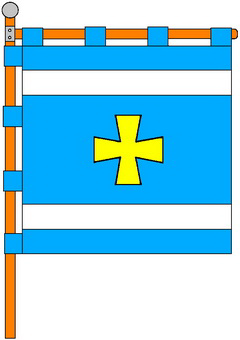|
Hannopil, Khmelnytskyi Oblast
Hannopil () is a village located in Shepetivka Raion of Khmelnytskyi Oblast of Ukraine. It hosts the administration of Hannopil rural hromada, one of the hromadas of Ukraine. Landmarks include the graves of The Maggid of Mezrich and Reb Zusha of Annapoli. Hannopil (in Ukrainian: Ганнопіль) is a village located in the Slavuta Raion, in the Khmelnitsky Oblast in Ukraine. The number of inhabitants in the 2015 census was 804 people. The postal code is number 30030. The telephone code is number 3842. The population covers an area of 4.58 square kilometers. History The village was known since 1602, with the name of Glinniki. In 1793, the village became part of the Volhynia Province of the Russian Empire. Between 1922 and 1991, the population was part of the Ukrainian Soviet Socialist Republic. Until 18 July 2020, Hannopil belonged to Slavuta Raion. The raion was abolished in July 2020 as part of the administrative reform of Ukraine, which reduced the number of raions of ... [...More Info...] [...Related Items...] OR: [Wikipedia] [Google] [Baidu] |
List Of Sovereign States
The following is a list providing an overview of sovereign states around the world with information on their status and recognition of their sovereignty. The 205 listed states can be divided into three categories based on membership within the United Nations System: 193 member states of the United Nations, UN member states, two United Nations General Assembly observers#Current non-member observers, UN General Assembly non-member observer states, and ten other states. The ''sovereignty dispute'' column indicates states having undisputed sovereignty (188 states, of which there are 187 UN member states and one UN General Assembly non-member observer state), states having disputed sovereignty (15 states, of which there are six UN member states, one UN General Assembly non-member observer state, and eight de facto states), and states having a political status of the Cook Islands and Niue, special political status (two states, both in associated state, free association with New ... [...More Info...] [...Related Items...] OR: [Wikipedia] [Google] [Baidu] |
Yiddish
Yiddish, historically Judeo-German, is a West Germanic language historically spoken by Ashkenazi Jews. It originated in 9th-century Central Europe, and provided the nascent Ashkenazi community with a vernacular based on High German fused with many elements taken from Hebrew language, Hebrew (notably Mishnaic Hebrew, Mishnaic) and to some extent Aramaic. Most varieties of Yiddish include elements of Slavic languages and the vocabulary contains traces of Romance languages.Aram Yardumian"A Tale of Two Hypotheses: Genetics and the Ethnogenesis of Ashkenazi Jewry".University of Pennsylvania. 2013. Yiddish has traditionally been written using the Hebrew alphabet. Prior to World War II, there were 11–13 million speakers. 85% of the approximately 6 million Jews who were murdered in the Holocaust were Yiddish speakers,Solomon Birnbaum, ''Grammatik der jiddischen Sprache'' (4., erg. Aufl., Hamburg: Buske, 1984), p. 3. leading to a massive decline in the use of the language. Jewish ass ... [...More Info...] [...Related Items...] OR: [Wikipedia] [Google] [Baidu] |
The Holocaust
The Holocaust (), known in Hebrew language, Hebrew as the (), was the genocide of History of the Jews in Europe, European Jews during World War II. From 1941 to 1945, Nazi Germany and Collaboration with Nazi Germany and Fascist Italy, its collaborators systematically murdered some six million Jews across German-occupied Europe, around two-thirds of Europe's Jewish population. The murders were carried out primarily through mass shootings and poison gas in extermination camps, chiefly Auschwitz concentration camp#Auschwitz II-Birkenau, Auschwitz-Birkenau, Treblinka extermination camp, Treblinka, Belzec extermination camp, Belzec, Sobibor extermination camp, Sobibor, and Chełmno extermination camp, Chełmno in Occupation of Poland (1939–1945), occupied Poland. Separate Nazi persecutions killed a similar or larger number of non-Jewish civilians and prisoners of war (POWs); the term ''Holocaust'' is sometimes used to include the murder and persecution of Victims of Nazi ... [...More Info...] [...Related Items...] OR: [Wikipedia] [Google] [Baidu] |
Zusha Of Hanipol
Rabbi Meshulam Zusha of Hanipol or Meshulum Zusil of Anipoli (1718–1800), Reb Zusha, Reb Zushe, The Rebbe Reb Zusha (sometimes spelled Zushye, Zusil, Zoussia, Zušya, Zushya, Zushia, Zisha of Anipoli) was an early Hasidic luminary and well-known tzaddik. He was one of the great Hasidic Rebbes of the third generation and member of the academy circle of the Maggid of Mezeritch. Biography Rabbi Zusha was the brother of Rebbe Elimelech of Lizhensk; Rabbi Elimelech was the elder by about 1 year. Both of them were born in the city of Tykocin ( Podlaskie), to Reb Eliezer Lipa(e), who was the son of the great Torah scholar Rabbi Elimelech (whom Rebbe Elimelech was named after). Rabbi Meshulam Zusha was named after his mother's father, also a great Torah scholar. Both Rabbi Zusha of Hanipol and Rabbi Elimelech of Lizhensk became prominent disciples of the holy Maggid of Mezeritch, part of his inner circle of students, known as the Chevraya Kadisha ("Holy Brotherhood"), together wi ... [...More Info...] [...Related Items...] OR: [Wikipedia] [Google] [Baidu] |
Mezeritch
Mezhirichi (; ) is a village in western Ukraine, in the Rivne Raion of Rivne Oblast, but was formerly administered within the Korets Raion. It is located west of Korets and east of Rivne. Local government is administered by Velykomezhyritska village council. Names Mezhirichi is also known as , , . Jewish life in Mezhirichi Undoubtedly the most significant event in the Jewish community of Mezhirichi was the arrival there of the Maggid, Rabbi Dov Ber of Mezeritch, Dov Ber. After the death of the founder of Hasidism, the Baal Shem Tov, in 1761, Rabbi Dov Ber became the next leader of the movement. He moved to Rivne, and later to Mezhrichi, where he remained for the rest of his life. Mezhrichi rapidly became a magnet and place of pilgrimage for the chasidim. The location of Mezhrichi, nearer to Poland and White Russia than the Baal Shem Tov's seat in Medzhybizh, acted as a spur to the fledgling chasidic movement. There is a Yizkor books, Yizkor book memorializing the Jewish ... [...More Info...] [...Related Items...] OR: [Wikipedia] [Google] [Baidu] |


